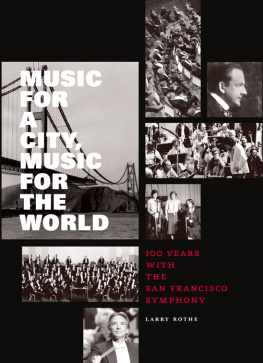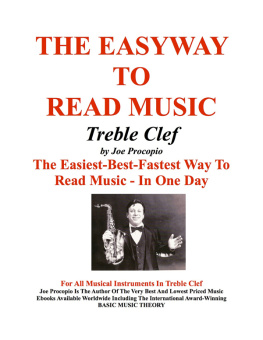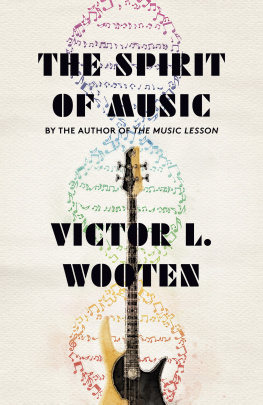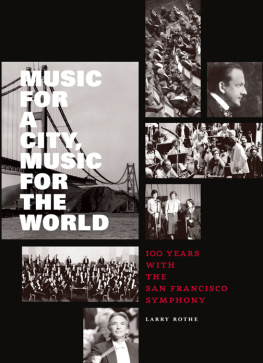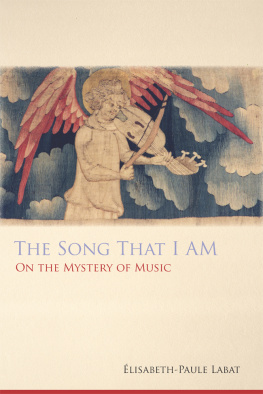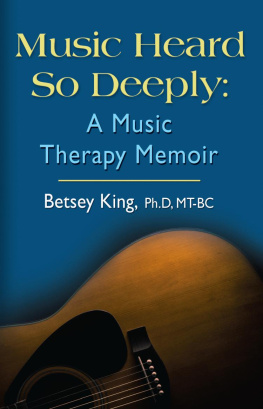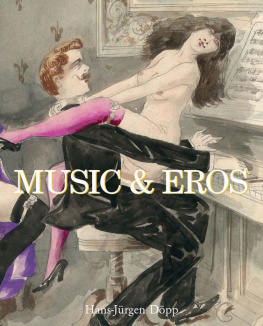Larry Rothe - Music for a City, Music for the World
Here you can read online Larry Rothe - Music for a City, Music for the World full text of the book (entire story) in english for free. Download pdf and epub, get meaning, cover and reviews about this ebook. publisher: Chronicle Books LLC, genre: Detective and thriller. Description of the work, (preface) as well as reviews are available. Best literature library LitArk.com created for fans of good reading and offers a wide selection of genres:
Romance novel
Science fiction
Adventure
Detective
Science
History
Home and family
Prose
Art
Politics
Computer
Non-fiction
Religion
Business
Children
Humor
Choose a favorite category and find really read worthwhile books. Enjoy immersion in the world of imagination, feel the emotions of the characters or learn something new for yourself, make an fascinating discovery.
- Book:Music for a City, Music for the World
- Author:
- Publisher:Chronicle Books LLC
- Genre:
- Rating:3 / 5
- Favourites:Add to favourites
- Your mark:
- 60
- 1
- 2
- 3
- 4
- 5
Music for a City, Music for the World: summary, description and annotation
We offer to read an annotation, description, summary or preface (depends on what the author of the book "Music for a City, Music for the World" wrote himself). If you haven't found the necessary information about the book — write in the comments, we will try to find it.
Music for a City, Music for the World — read online for free the complete book (whole text) full work
Below is the text of the book, divided by pages. System saving the place of the last page read, allows you to conveniently read the book "Music for a City, Music for the World" online for free, without having to search again every time where you left off. Put a bookmark, and you can go to the page where you finished reading at any time.
Font size:
Interval:
Bookmark:
To the artists and listeners, onstage and offstage, whose love of music is the heart of the San Francisco Symphony.
It started with the end of a world. The earthquake of 1906 destroyed one San Francisco and gave birth to another, also to a new orchestraaimed at revitalizing the citys cultural life. Packed into that simple statement of ambition is a century-long story.
That story is a tale of transformation and evolution, about how people who understood musics power began with an idea, then shaped it into a cultural institution. Today we call the San Francisco Symphony great. That reputation was not conferred at birth. Such enterprises are always works in progress. We tend to see the progress thus farthe path that has led to this point a hundred years lateras a constant trajectory, proceeding at a single speed, the target in sight and the movement sure. Closer examination always reveals starts and stops, periods of relative stasis and exhilarating times of rapid acceleration. Closer examination reveals the dramas that emerge as obstacles are recognized and surmounted.
This story of the San Francisco Symphony is such an examination. As anyone who has climbed a trail to the summit knows, some parts of the ground are easier to cover than others. History is about stubborn movement forward, the different velocities that press against the wall of a future that is yielding in some places and resistant in others.
Symphony history is populated by men and women and the music they loved and continue to love. Some of the characters are outmatched by circumstances. Others wrestle circumstances to the floor. Some are simply well-intentioned. Others are visionary. Because music never exists apart from the larger and smaller universes in which it is born, this is also a story of an organization whose own history is interwoven with the histories of city, state, country, world. And while every orchestra in the United States can tell its own saga of public support, in San Francisco, the citys music lovers have been crucial to the Symphonys very existence.
Music, for its listeners, is something that exists not on the page, but in performance. Every performance is a transformation, too, one that brings music to life and to our lives. This alchemy, when the score becomes sound, demands powers of imagination and execution that seek to match the musics stature. Those who make music have no choice but to strive for greatness. Over the course of a century, the San Francisco Symphony has defined itself as an ensemble equal to those demandsmore equal to them at some times than at others, although the mission has always been to bring music, and all that music means, to those hungry for it and to those for whom a first taste might lead to a second. Music is a gift for everyone, not just for select provinces of society. From the start, the Symphony made performances affordable and widely available. And as technologies developed, new audiences were reached in new ways. All this is part of the story, and part of the continuing story.
For the story continues, and whoever documents the Symphonys bicentenary will have a richer tale to tell. I tell of the San Francisco Symphonys birth, struggles, and achievements beginning with pre-earthquake San Francisco, to the orchestras first performance in 1911, and through its first hundred years. I have attempted to be objective but not dispassionate, have tried not to overlook drama where it exists nor create drama where it is absent. For helping me tell this story I am indebted to many, beginning with the musicians of the San Francisco Symphony (current and former), specifically (in alphabetical order): Alexander Barantschik, Chris Bogios, Charles Burrell, Stuart Canin, Don Carroll, Don Ehrlich, Jorja Fleezanis, Detlev Olshausen, Stephen Paulson, Scott Pingel, Paul Renzi, Peter Shelton, Robin Sutherland, and Jack Van Geem. For taking time from all-but-impossible schedules to speak with me, I thank the Symphonys current music director, Michael Tilson Thomas, and his two immediate predecessors, Herbert Blomstedt and Edo de Waart. Symphony President John D. Goldman and Executive Director Brent Assink supported this project from conception to completion. Among board members (current and former) who shared recollections were Ava Jean Brumbaum, Katherine Buchanan, Ellen Magnin Newman, and Genelle Relfe. I am grateful also to Joseph A. Scafidi, who joined the Symphony as jack-of-all-trades in 1939 and left as executive director in 1978, and to former executive director Peter Pastreich, who served in that post for twenty years. Both offered their reminiscences with wonderful generosity and candor; in addition, Pastreich made valuable suggestions on the manuscript. Director of Marketing, Communications and External Affairs Nan Keeton provided the experience, expertise, and direction that helped transform the project from idea into finished product. Along with Brent Assink, she also offered invaluable input on the manuscript, as did these other insightful readers: Caroline Colburn, Scott Foglesong, John Goldman, Gregg Gleasner, Polly Ikonen, John Kieser, Ellen Magnin Newman, and Oliver Theil. Kathy Brown, Katherine Cummins, Marie Dalby, and Jeanette Yumy colleagues in the Symphonys Publications Departmentensured seamless department operations throughout the year in which I focused my concentration on this book. Music critic and writer Allan Ulrich conducted oral history interviews with former concertmaster Stuart Canin and violist Detlev Olshausen. Jason Gibbs of the San Francisco Public Library provided access to the librarys rich collection of Alfred Hertz materials. Leta Miller of the University of California at Santa Cruz is probably the worlds leading authority on Hertz and generously made her own original research available. Symphony Archivist Joe Evans and his associate, Kelly Chatain, have been crucial to this project from the start. Joe was a never-ending source of guidance, stimulation, knowledge, and moral support; he and Kelly also spent hours assembling the many images, with which the books designer, Cinthia Wen, and her associate, Ed Ng, have illustrated the Symphonys history. My editor at Chronicle Books, Micaela Heekin, was tough, thorough, and inspiring; she possesses an editors most essential asset, the rare power to be at once firm and unobtrusive. I am grateful also to Jeff Campbell, an extraordinarily scrupulous copy editor. Finally, I thank my wife, Karen Borst-Rothe, for the tough love with which she reviewed each chapter as it emerged and reemerged, and for the reassurance and good humor with which she bolstered me throughout.
No writer can produce a history such as this alone, but every writer knows that the final job of creating a felicitous and accurate account belongs only to one person. And so, having offered thanks to those who have helped along the way, I take sole responsibility for any infelicities or inaccuracies in what follows.
1 The Palace Hotel and Lottas Fountain in the years before the earthquake. Built in 1875, the largest hotel in the West welcomed such visitors as Alfred Hertz and Enrico Caruso.
PRELIMINARIES: ON CIVILIZATIONS FRONTIER
In April 1905, the conductor of New Yorks Metropolitan Opera, happy to have arrived in San Francisco with the companys touring ensemble, reflected on the trials of a crosscountry journey. From his suite in the Palace Hotel on lower Market Street, he wrote to an East Coast associate telling what he had encountered once he had left New York civilization. In Cincinnati, a bellboy greeted his complaint about poor service with an invective against this damned opera company. In Minneapolis, the hotel restaurant shut its doors by nine in the evening. In Kansas City, a municipal ordinance forbade sale of mineral water on Sundays. A neighborhood church there offered a special twenty-five-cent Parsifal Dinner in honor of the opera the Met had presented in a local auditorium, a place whose fifteen-thousand-seat vastness defeated even an orchestra of Wagnerian size, and where a shouting spectator interrupted the performance, demanding a refund because he could not see the stage. In San Francisco, the maestro concluded, and a good deal like Paris.
Font size:
Interval:
Bookmark:
Similar books «Music for a City, Music for the World»
Look at similar books to Music for a City, Music for the World. We have selected literature similar in name and meaning in the hope of providing readers with more options to find new, interesting, not yet read works.
Discussion, reviews of the book Music for a City, Music for the World and just readers' own opinions. Leave your comments, write what you think about the work, its meaning or the main characters. Specify what exactly you liked and what you didn't like, and why you think so.

